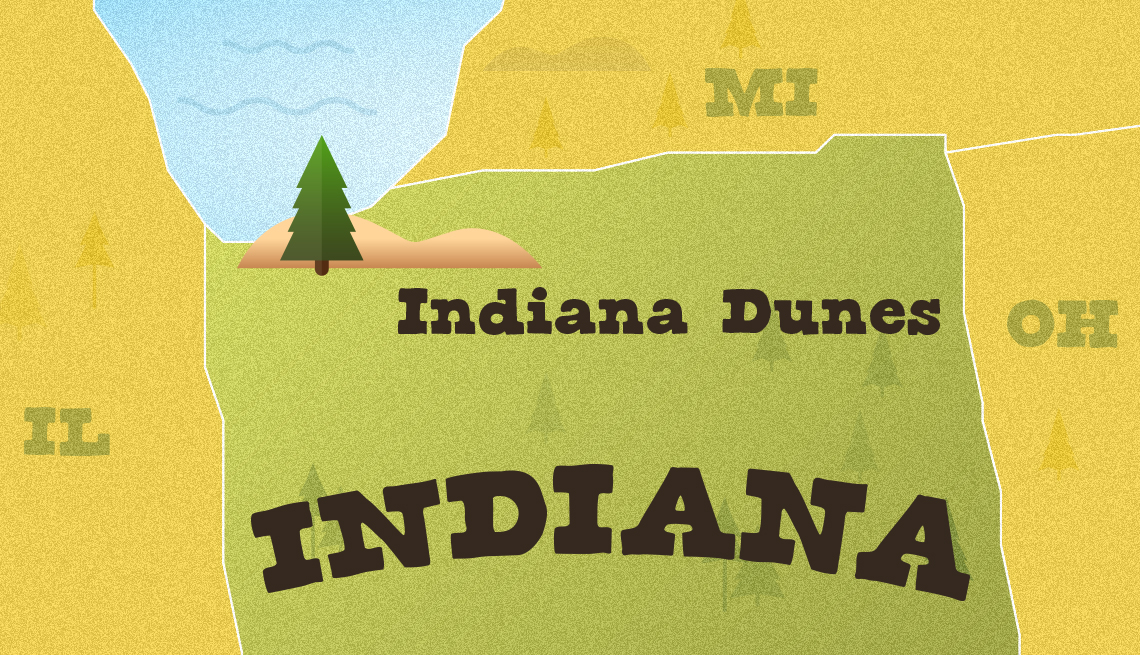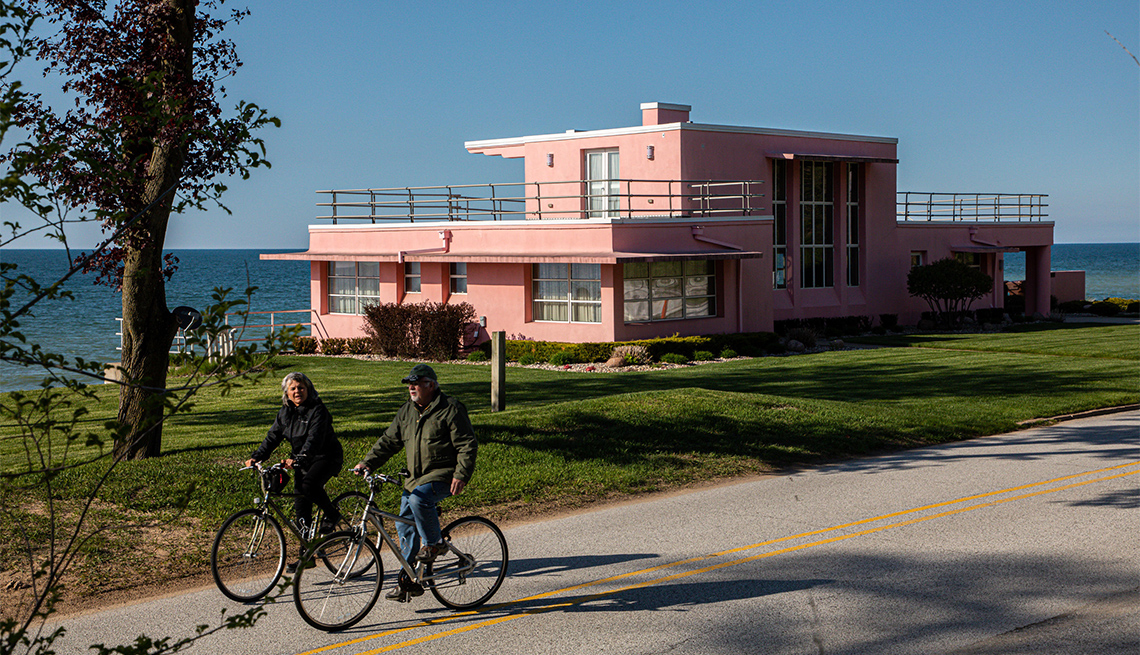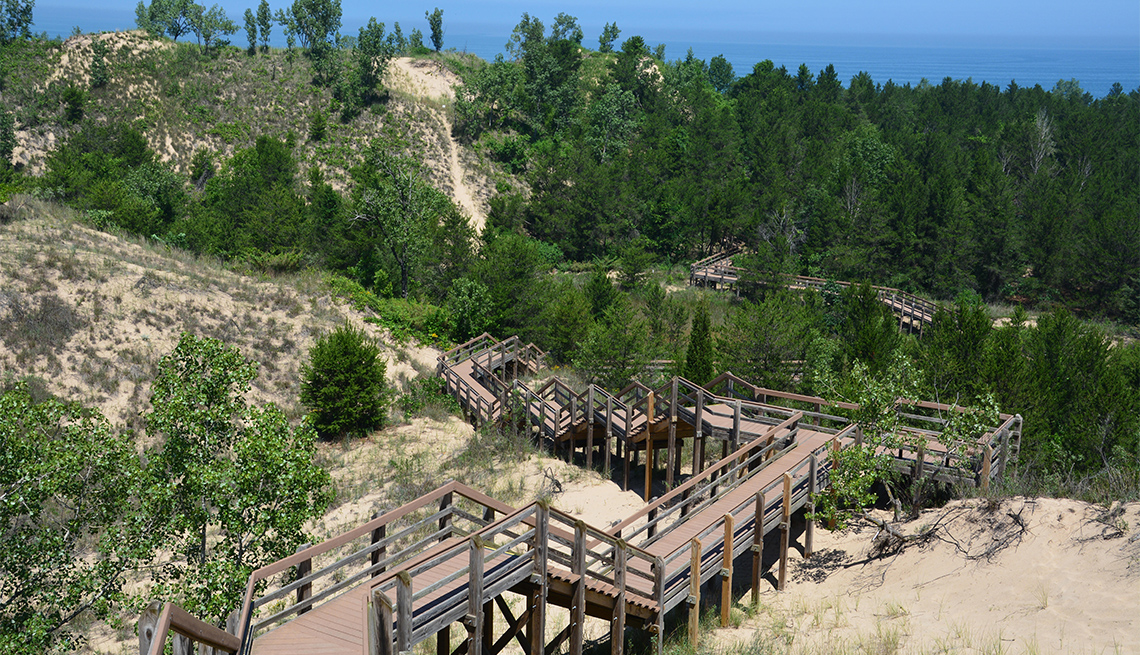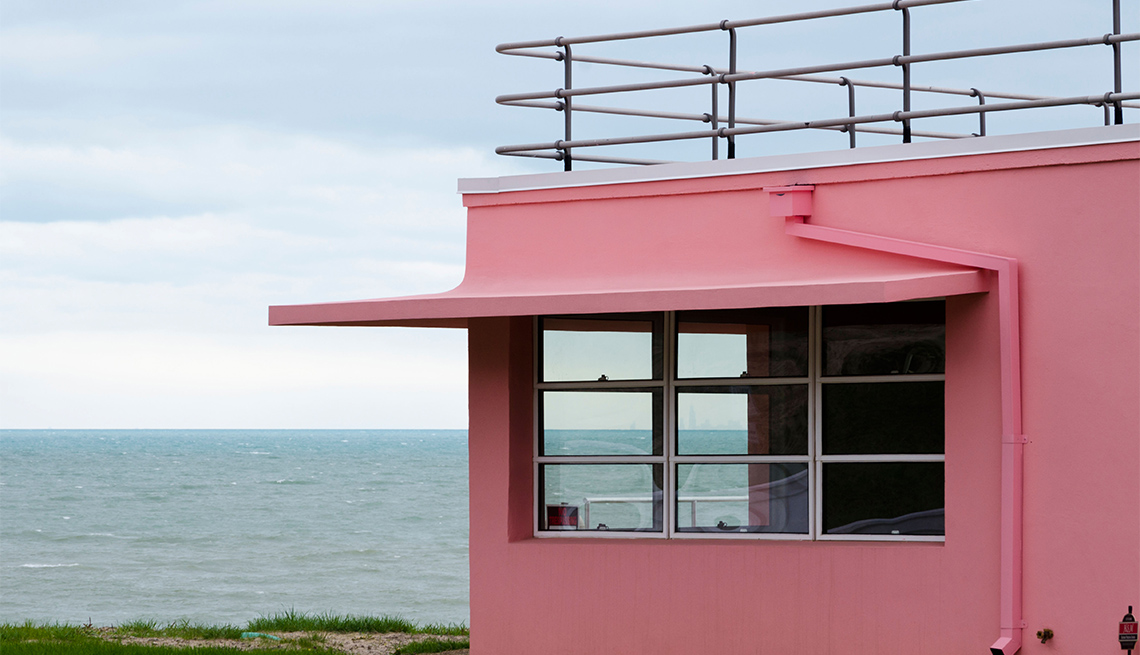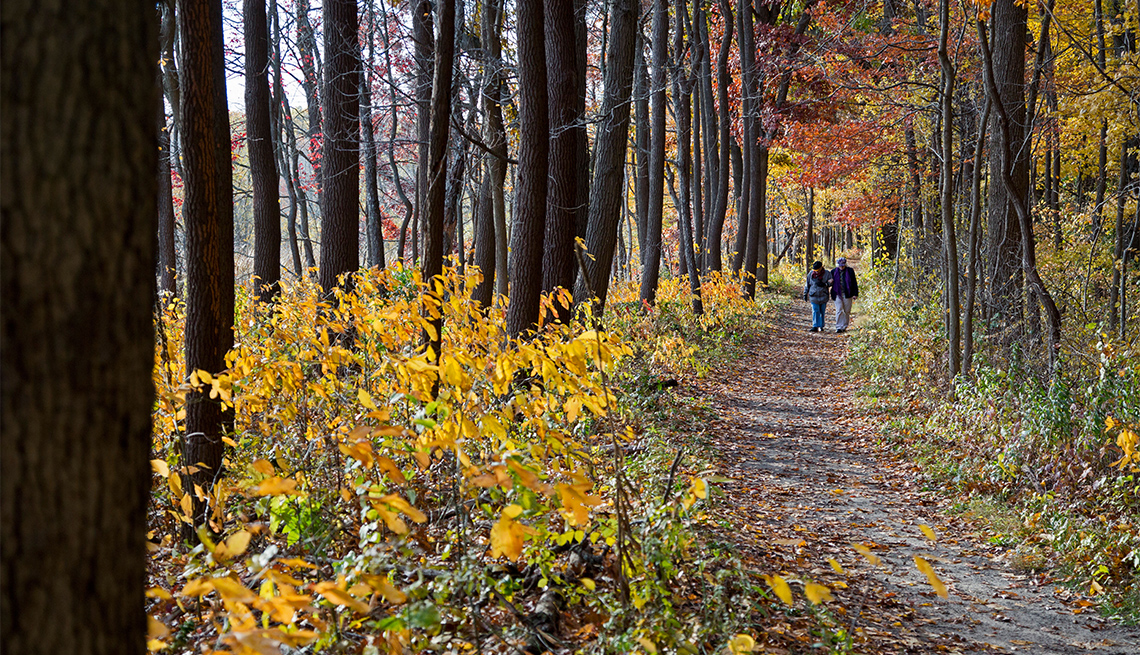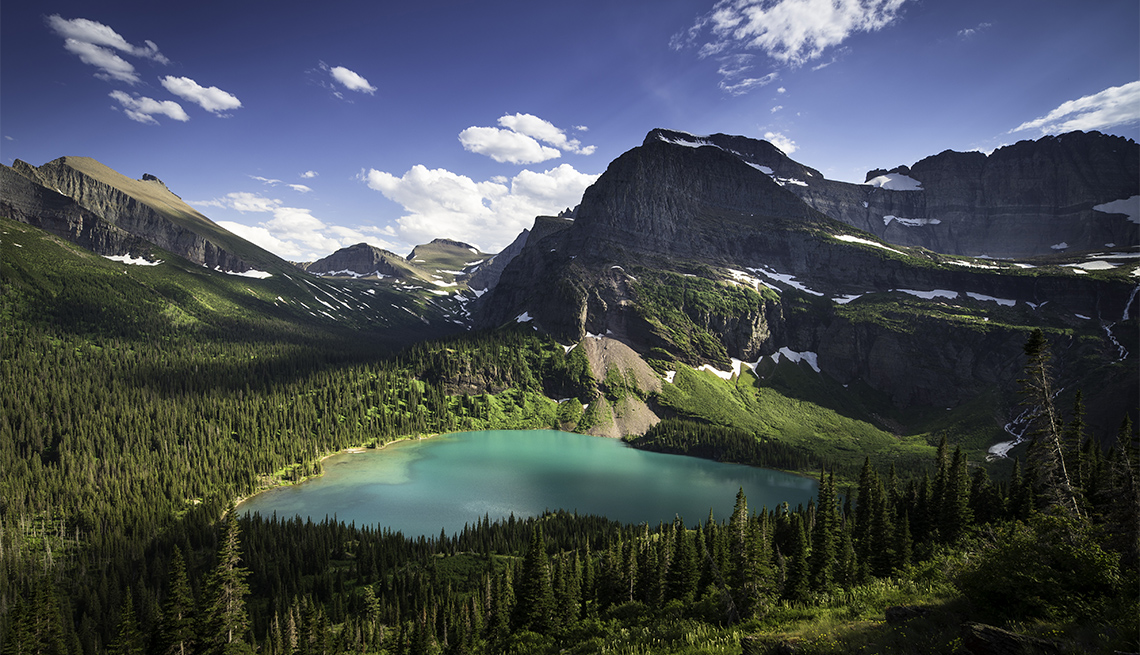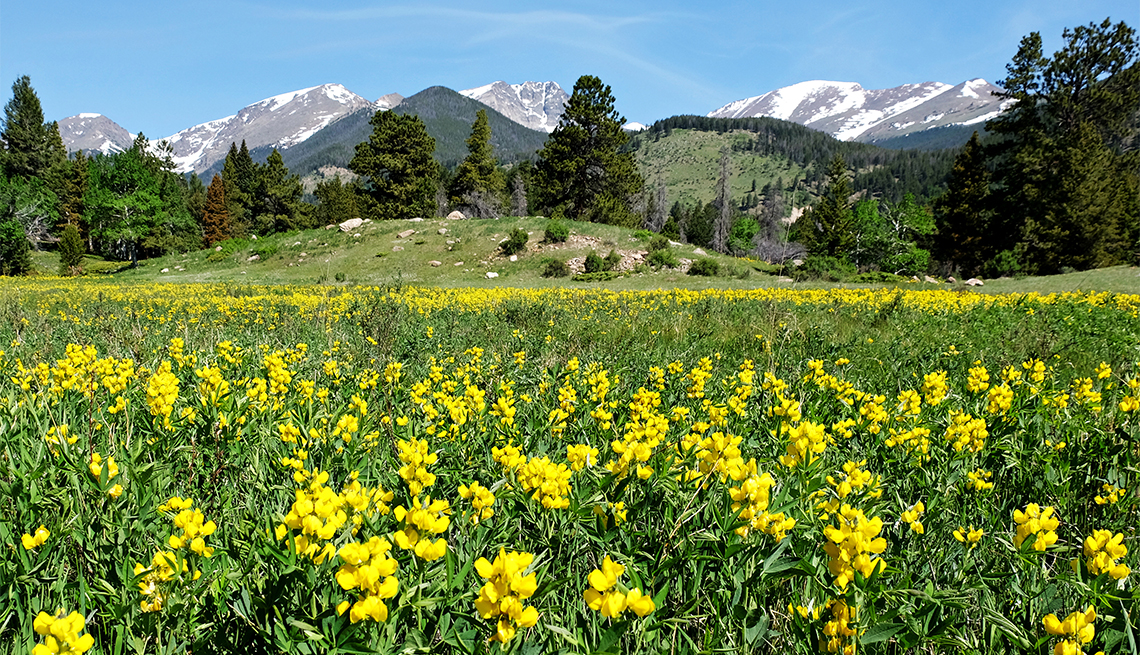AARP’s Guide to Indiana Dunes National Park
Everything you need to know about visiting this lakeside treasure near Chicago
En español | The nation's best-known national parks largely preserve grand landscapes with stunning, sweeping vistas. Indiana Dunes National Park (IDNP) is about the little, but no less vital, wonders of nature, including the natural succession of sand dunes over millennia, the dependency on fire to restore rare black oak savannas, and the vitality of plant biodiversity. Home to more than 1,100 plant species — from Arctic mosses to desert cactus — the park is considered one of the most botanically diverse in the national park system.
Strung along 15 miles of Lake Michigan in northern Indiana, less than 40 miles southeast of downtown Chicago, the fragmented, 15,000-acre park shares the shore with a steel plant and an industrial harbor, which make the treasures found here even more astonishing. The tensions between conservation and development are seminal here and date back to 1899, when University of Chicago Prof. Henry Chandler Cowles — a botanist whose name you'll see plenty around the park — published a study on plant succession in the dunes, helping to establish the field of ecology in the U.S. The National Park Service's first director, Stephen Mather, backed the formation of the park in 1916, but sand harvesting and the World War I-inspired rush to industrialization steamrollered the effort. Despite the loss to mining of 200-foot Hoosier Slide, the area's tallest dune, the push for the park's creation continued and the area eventually earned National Lakeshore designation in 1966 and an upgrade to National Park status in 2019.
"It was identified early on as a really outstanding natural area relatively close to the urban area of Chicago,” says Bruce Rowe, supervisory ranger and public information officer at the park, which welcomed a record 2.3 million visitors in 2020. “Sand dunes caught people's attention with their rugged and wild beauty."
The lakefront is, by far, the park's most popular attraction, but for birders, explorers and nature lovers, the woods that cover the rolling inland hills — once lakeside dunes themselves — offer refreshingly uncrowded trails presenting a different character in each season.
Location: Porter, Indiana
Acreage: 15,000 acres
Highest peak: Mount Baldy at 126 feet
Miles of trails and how many: 50 miles of trails across 14 trail systems
Main attraction: Sand dunes
Cost: Free; parking at West Beach in summer is $6
Best way to see it: Driving the Red Arrow Highway
When to go to avoid the crowds: Spring
Plan Your Trip
Relative to many other remote national parks, IDNP is on the beaten path, virtually in the backyard of Chicago, less than 40 miles northwest, and the starting point of many a day-tripper here. Indianapolis lies 160 miles south.
Getting to IDNP from Chicago by either Interstate 94 or the parallel toll road Interstate 90, you'll feel you've hardly left the gritty city when you exit at Gary, Indiana, the park's westernmost entryway and a city synonymous with steel mills. But proving nature's resiliency, the dunes and forests persist minutes from Gary's factories and smokestacks.
Perhaps fittingly then, IDNP is a driver's park. Though you can also reach it via railroad — the South Shore Railroad departing from Chicago has four park stations — a car helps you get around and beyond the occasional industrial pockets and to its main visitor center, focusing on orientation, and the Paul H. Douglas Center for Environmental Education, offering ranger-guided events and children's programming. The two-lane Highway 12, known as the Red Arrow Highway, is the park's 22-mile main thoroughfare, stringing together trail access points, park attractions and small towns between Gary and Michigan City (the park's eastern boundary) that would be difficult to get to on foot.
Consider visiting this park more than once, as the seasons change the experience dramatically. The beaches are busy in summer, but the park is quiet and often beautifully covered in frost or snow in winter. A snowstorm blowing down the lake brings out cross-country skiers and snowshoers. Come in fall to catch color season on the trails and in spring to see returning birds and those migrating along the Lake Michigan Flyway.
Because admission is free, it's easy to come and go frequently at the park. Being near a major city, it has good cellular service. And because it's also dispersed, the park has many picnic areas and public bathrooms, not just at the visitor centers, but at attractions and some trailheads.
Many trails over the dunes require strenuous uphill climbing, sometimes in sand, which makes it harder to gain a foothold, and sometimes via stairways erected to protect against erosion. But many of the trails are gentle and often have benches for taking breaks.
Where to Stay and Eat
Dunewood Campground, the park's only campsite, is open April through October and hosts just 66 sites — 53 for RV drive-in stays and 13 for tents only. The cost is $25 per night and sites should be reserved well in advance at recreation.gov.
Complicating IDNP's fragmented boundaries even more, Indiana Dunes State Park occupies its own 2,200 shorefront acres surrounded by the national park. Admission to the state park ($12) is separate and its nearly 150 campsites cost $25 and $32, depending on the day of the week. Reservations open six months in advance and can be scarce in summer.
If you're not a camper, you can opt for any of the area's many chain hotels, vintage motels, inns, rental homes and B&Bs (find a list at indianadunes.com/places-to-stay). In Chesterton, each of the four rooms at the At Home in the Woods Bed and Breakfast (from $159) has a theme from a different national park. A pool, sauna and hot tub add to the B&B's appeal. Forty acres generously buffer the 12-room Brewery Lodge & Supper Club (from $79) in Michigan City, with a restaurant tucked into a 1930-vintage brick home.
You won't find any food concessions in the park, but the surrounding communities happily feed visitors with everything from fast-food stands to breweries, Mom ‘n’ Pop sandwich shops, food trucks, coffee shops and cafés (browse the list at Indiana dunes .com). Insider tip: Given IDNP's splendor, take food into the park during the daytime for a picnic at the beach or on a trail. Stop in to Goblin & the Grocer in Beverly Shores for upscale sandwiches, such as the Caprese, and homemade clam chowder.
Things to Do
Most visitors, especially in summer, head straight for the Lake Michigan beaches to cool off (despite the year-round chilly water). But IDNP, though small, is a rangy park and rewards explorers with many diversions from its main thoroughfare, the Red Arrow Highway, including the following highlights.
Revel in a rare oak savanna: The “ridges and swales” of Miller Woods, as Prof. Cowles noted in the 1890s, reveal the presence of glaciers some 3,000 years ago. The undulating landscape on the park's west side — between Miller Woods and nearby Tolleson Dune — nurtures an endangered black oak savanna, a 1,042-acre sparsely wooded grassland with fire-resistant oaks in which prairie plants flourish, producing stunning wildflower blooms in spring and early summer, including bird-foot violet, lupine, mountain honeysuckle and pasture rose. The Park Service manages fires here to maintain this diverse habitat and prevent the trees from taking over, a natural process once sparked by lightning. At Miller Woods, some 3.2 miles of easy loops and interconnecting trails also reach the Lake Michigan shore and pass wetlands, which are particularly good places to bird-watch.
Do the dunes: One of the park's signature dunes, 126-foot Mount Baldy has been moving inland rapidly as a result of human intervention in the lake, but it's still a beauty to behold. The 1.5-mile moderate round-trip trail at Mount Baldy (not wheelchair-accessible) actually goes around the giant dune, visible from the parking lot, to prevent more erosion and to protect hikers from invisible sinkholes that form around sand-covered trees. Take the short, somewhat steep descent to the beach to ogle Baldy from the lakefront.
Explore more dune succession on the 3.4-mile 3-Loop Trail at West Beach, which has extensive boardwalks and stairways that put you in and around the dunes without contributing to erosion. The stair-climbing can be exhausting, but you'll get stunning views of the lake, jack pine groves, isolated ponds and undulating dunes.
For sheer height, climb three of the coast's tallest dunes — Mount Tom, Mount Holden and Mount Jackson, at 192, 184 and 176 feet, respectively — at neighboring Indiana Dunes State Park. The pitch of the dunes and the loose sand underfoot makes these trails challenging; in fact, doing all three is known as the 3 Dune Challenge.
Get bogged down: Named for Prof. Cowles, who studied plant evolution here, Cowles Bog is a roughly 205-acre wetland notable for its plant diversity. The moderate 4.7-mile Cowles Bog Trail takes you past its many habitats, including black oak savannas, lakefront dunes, marshes and ponds. If you're looking for a daylong hike, try this one and pack a lunch for picnicking lakeside.
Tour five futuristic homes: You know you're in a quirky park when a flamingo-pink modernist home perched atop a lakefront dune with views back across the lake to Chicago ranks as one of the major sights. The stucco Florida Tropical House is one of five Century of Progress Homes displayed at the 1933 World's Fair in Chicago as examples of modern design and models of experimental materials. At the fair's end in 1935, a real estate developer shipped the homes across the lake by barge to attract home buyers to his new resort community of Beverly Shores, which the park now surrounds. On a self-guided tour, stroll the open-air time capsule created by this cluster of architectural icons on Lake Front Drive. Most times of the year, you can't go inside the homes, but you can read informational panels in front of them. Insider tip: The nonprofit Indiana Landmarks, which leases most of the homes to residents who pay for their leases by improving the properties, opens them for tours each September.
Meet early park residents: Native Americans, traders and immigrant farmers populated this dunes region before it became a national park or even a botany research subject. Learn about early inhabitants of the area at the Chellberg Farm and neighboring Bailly Homestead. The house and barn built by the Swedish Chellberg family in the 1870s hosts an apple festival each September and rangers offer guided tours of the farmhouse, animals and vegetable garden weekly from late June to mid-August. Volunteers run the farm operations, including a “sugar shack” for making maple syrup from tree sap.
From the farm, it's a shady, third-of-a-mile walk through a dense forest banking the Little Calumet River to reach the Bailly Homestead, an original 1822 fur trading post and one of only two stops for missionaries, traders and travelers between Detroit and Chicago at the time, now designated a National Historic Landmark. Though their interiors are closed, the grand house and hand-hewn log outbuildings transport visitors to an earlier age when the leafy compound was a bustling center of early 19th-century life. Immerse yourself in the past through free weekly ranger-led Bailly/Chellberg History Hikes, June through August (no registration required; see the events page at the park website).
For an in-depth experience: Pinhook Bog preserves the region's glacial past created of a former kettle lake left behind by melting glaciers that eventually became acidic, supporting floating mats of sphagnum moss, orchids, ferns and, most intriguing, carnivorous plants such as pitcher plants and sundew. A vulnerable and rare ecosystem, the bog is only open in summer during ranger-led tours, which fill up quickly (sign up by calling the visitor center).
AARP Membership -Join AARP for just $15 for your first year when you enroll in automatic renewal
Join today and save 25% off the standard annual rate. Get instant access to discounts, programs, services, and the information you need to benefit every area of your life.
Gateway Towns
IDNP has many gateways, including Gary and Michigan City at either end, smaller towns inland — including Porter and Chesterton — and, of course, Chicago nearby.
Gary: You'll pass through Gary to get to Miller Woods via Lake Street. Though the city is highly industrialized, its small Lake Street commercial strip is worth a stop for its few galleries and gift shops (duck into Indie Indie Bang Bang for its design-centric housewares and gifts) and its eating and drinking spots. At Miller Pizza Co., order your pie Chicago deep-dish style or thin, and take advantage of its bargain weekday lunch specials. After a hike, reward yourself with one of the refreshing craft beers at nearby 18th Street Brewery.
Michigan City: At the park's other end, Michigan City is a much more robust gateway, especially with its lavish Blue Chip Casino on Trail Creek downtown. There, besides gambling, you can check into one of its 486 rooms; dine in a steak house, sports bar or deli; and book rejuvenating spa treatments. In the downtown, pedestrian-friendly lakefront, learn about the city's history at the 1858 Michigan City Lighthouse, now a museum, and the 35,000-square-foot Barker Mansion, built in 1857 by John Barker Sr., president of a railroad freight car company, and now a museum celebrating life during the Gilded Age (now closed for renovations, but check back for opening dates).
Enjoy the breezy spirit of Bridges Waterside Grille from the deck overlooking a marina for casual pub fare (try the fried shrimp po'boys and barbecued beef brisket). Grab an 1871 American pub ale, a burger and a live music set at Zorn Brew Works.
Northern Indiana: From Michigan City, you can also explore the many agricultural attractions in this area of the state. On the fringes of Michigan City, pick blueberries at Stateline Blueberries a few miles northeast of the waterfront, and taste-test the unoaked chardonnays made with Sonoma County grapes at nearby Shady Creek Winery. Pair them with charcuterie, cheese plates and pizzas indoors by the fire or out on the patios.
Smaller towns: Edging the park on the inland side, Chesterton and Portage both have many chain hotels (see indianadunes.com for a list). For retro kicks, order a home-brewed root beer and a chili dog at the Port Drive-In, a 1958-vintage drive-in restaurant in Chesterton.
En Route
From Chicago: Pay homage to Prof. Cowles at the University of Chicago in Hyde Park, on the Windy City's southside with a stroll on its main campus, modeled on English Gothic style (think of the University of Oxford). Stop into the tranquil Plein Air Café just off campus, next to Frank Lloyd Wright's Robie House, for a cold brew and a hazelnut beignet on the leafy patio. If you're a bird lover, check out the nearby Wooded Island in Jackson Park, a hot spot where the Chicago Audubon Society leads regular birding walks each Saturday morning.
From the east: Stop in South Bend, Indiana, to wander through the Studebaker National Museum. The 55,000-square-foot facility showcases the world's largest collection of U.S. Presidential Carriages (before they had cars), including the barouche that President Lincoln used the night of his assassination, as well as an array of Studebaker and Packard automobiles, originally made in South Bend.
Just a few blocks from the museum, dine in the mansion that a member of the auto-making family, Clem Studebaker, built between 1886 and 1889. Called Tippecanoe Place, it now houses a landmark restaurant (the French onion soup and prime rib are musts) and a more casual beer-centric lounge in which you can revel in the 19th-century architecture.
From Michigan: The 30 or so miles of shoreline north of the Indiana border, collectively called Harbor Country, draws vacationing Chicagoans. At Warren Dunes State Park, about 23 miles from Michigan City, delight in running down the dunes onto the beach; and in small towns, stop to shop, eat and treat yourself at ice cream parlors. Just over the Indiana-Michigan border in New Buffalo, line up for a Velveeta-topped cheeseburger at the thronged, cash-only roadhouse Redamak's, a local legend for its cheeseburgers.
- |
- Photos
Elaine Glusac, a Chicago-based journalist, writes the Frugal Traveler column for the New York Times.
Also of Interest
- |
- Photos


